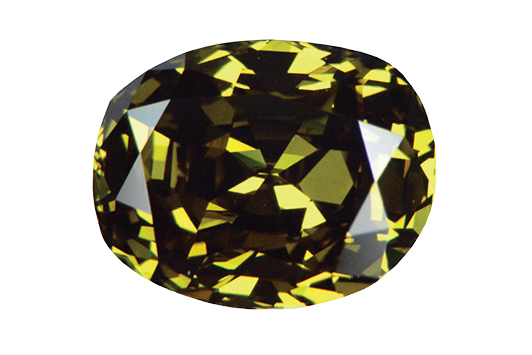
Centuries ago, people would describe diamond colors — including colorless — using nature as a reference point, with comparisons to beverages, conch shells, birds, flowers, spices and even clear water. Overall, the industry still uses these references. However,
the Gemological Institute of America (GIA) created 27 hue names for fancy-colored stones on a continuous hue circle, using color science, new terminology, and a set of criteria for standardizing the descriptors.
“The GIA in New York are the most experienced people with fancy-colored diamonds,” says Andrew Coxon, president of the
De Beers Institute of Diamonds. “They were the first to start grading them in the early ’70s.”
But how best to cut them? Unlike their colorless siblings, these diamonds are customarily cut to maximize color intensity rather than light return, clarity or carat weight.
“What is good for non-fancy colors is detrimental to fancy colors,” explains Coxon. “Saving the face-up color is much more important than polishing away as many internal inclusions as possible.”
The stone’s final size, shape and facet arrangements are the factors that have the greatest effect on colored diamonds. The larger the stone, or the deeper its pavilion, the further light can travel in it. This can often lead to a deeper, more powerful hue.
“Step cuts give the best yield but do not always trap the most face-up color,” elaborates Coxon. “That is why the radiant, a mix of step and brilliant faceting styles, is often the most preferred cut for fancy-colors. The least popular is the round brilliant, as it tends to lighten the face-up color of all diamonds.”
Trade secrets
With good reason, diamond manufacturers are not keen on sharing their secrets for cutting fancy-colored diamonds. However, Coxon does drop a few hints.
“The finest and most famous polisher of fancy colors lives and works in New York,” he says. “His name begins with M and ends in S — that is all I will share. There are very few experts who can be trusted with the rarest of fancy colors.”
This reluctance to discuss cutting methods is “possibly because [manufacturers] make a good business out of recutting a GIA-graded fancy-colored diamond — usually by changing the facet angles, especially around the culet, sometimes adding a few extra facets to enhance the color before resubmitting to the GIA and achieving a rarer color grade and a 50% uplift in value,” he continues. “You have to look at the overall beauty, not only the grading report — which is [also] important — to value a fancy-color diamond.”
A good eye
No special tools are necessary for the process, other than standard manufacturing equipment. However, “the most important tool is the expert eye of the most experienced artisan, like Mr. M,” says Coxon. The anonymous cutter “is often asked to recover the color that was lost when the wrong facet angles or proportions were applied by a lesser expert polisher.”
Mr. M’s expertise comes in large part from his experience with so many stones, Coxon suggests. “It is fair to say that Mr. M is asked to cut and polish many of the most valuable fancy-colored diamonds in the world. So seeing as many fancy colors as you can is the secret to training your eye and your valuation skills.”
One of Coxon’s own secrets is to “beware of [diamonds that] look bright and beautiful in the rough.” Because “each one must sacrifice over half of its original weight,” he says, “the fancy color can become lighter. However, if the color [of the rough] looks unattractive but deep in intensity, very often that is the one which produces the most beautiful fancy-color surprise.”
Image: Diamond Faceting, Inc Article from the Rapaport Magazine - November 2022. To subscribe click here.